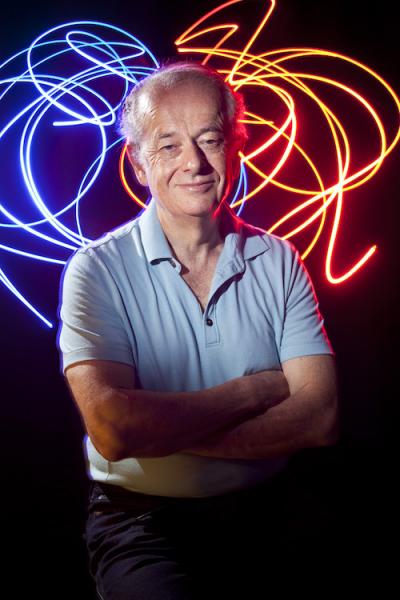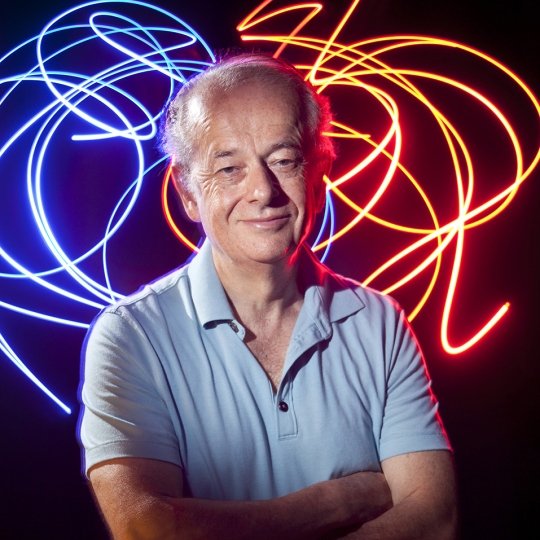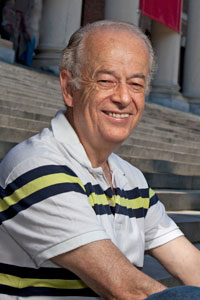News
Federico Capasso, the Robert L. Wallace Professor of Applied Physics and Vinton Hayes Senior Research Fellow in Electrical Engineering. (Eliza Grinnell/Harvard SEAS)
CAMBRIDGE, MA | December 8, 2015 — The American Academy of Arts and Sciences has named physicist Federico Capasso and electrical engineer Alfred Cho as the recipients of the 2015 Rumford Prize in recognition of their contributions to the field of laser technology. This award will be presented to Capasso and Cho, both of whom are members of the Academy, on April 14, 2016 at the Academy’s headquarters in Cambridge, Massachusetts.
At Bell Laboratories in 1994, Capasso and Cho invented the quantum cascade (QC) laser, a concept first proposed by Rudolf Kazarinov and Robert Suris in 1971. A revolutionary new light source, the QC laser is widely used as a source of radiation for chemical sensing and spectroscopy. Common commercial applications of QC lasers include trace gas analysis, medical diagnostics, and pollution monitoring.
First awarded in 1839, the Rumford Prize is one of the oldest scientific prizes in the United States. The prize recognizes contributions to the fields of heat and light, broadly defined. Previous Rumford Prize recipients include: Thomas Edison, in 1895, for his work in electric lighting; Edwin Land, in 1945, for his applications in polarized light and photography; Enrico Fermi, in 1953, for his studies of radiation theory and nuclear energy; and Sidney Drell, Sam Nunn, William Perry, and George Shultz, in 2008, for their collective efforts to reduce the global threat of nuclear weapons.
“On behalf of the American Academy, I am pleased to present the Rumford Prize to Dr. Capasso and Dr. Cho for their achievements,” said Jonathan F. Fanton, President of the American Academy of Arts and Sciences. “Along with Louis Agassiz, Alexander Graham Bell, Albert Einstein, Niels Bohr, and others, they are part of a distinguished lineage of scientists who have been Academy members. We are proud to have highly accomplished scientists like Dr. Capasso and Dr. Cho as part of our membership.
 Federico Capasso is the Robert L. Wallace Professor of Applied Physics and Vinton Hayes Senior Research Fellow in Electrical Engineering at the Harvard John A. Paulson School of Engineering and Applied Sciences which he joined in 2003 after 27 years at Bell Labs where he was Member of Technical Staff, Department Head and Vice President for Physical Research. A member of the American Academy of Arts and Sciences, he is also a member of the National Academy of Sciences, the National Academy of Engineering, the Academia Europaea and a foreign member of the Accademia dei Lincei (Lincean Academy). He has received numerous awards recognizing his achievements in nanoscale science and technology, which include the IEEE David Sarnoff Award in Electronics (1991), the Materials Research Society Medal (1995), the Wetherill Medal of the Franklin Institute (1997), the Rank Prize in Optoelectronics (1998), the Robert Wood Prize of the Optical Society of America (2001), the American Physical Society’s Arthur Schawlow Prize in Laser Science (2004), the IEEE Edison Medal (2004), the King Faisal International Prize for Science (2005), the Berthold Leibinger Zukunft Prize (2010), the Jan Czochralski Award for lifetime achievements in Materials Science (2011), the European Physical Society's Prize for Applied Aspects of Quantum Electronics and Optics (2013), and the SPIE Gold Medal (2013).
Federico Capasso is the Robert L. Wallace Professor of Applied Physics and Vinton Hayes Senior Research Fellow in Electrical Engineering at the Harvard John A. Paulson School of Engineering and Applied Sciences which he joined in 2003 after 27 years at Bell Labs where he was Member of Technical Staff, Department Head and Vice President for Physical Research. A member of the American Academy of Arts and Sciences, he is also a member of the National Academy of Sciences, the National Academy of Engineering, the Academia Europaea and a foreign member of the Accademia dei Lincei (Lincean Academy). He has received numerous awards recognizing his achievements in nanoscale science and technology, which include the IEEE David Sarnoff Award in Electronics (1991), the Materials Research Society Medal (1995), the Wetherill Medal of the Franklin Institute (1997), the Rank Prize in Optoelectronics (1998), the Robert Wood Prize of the Optical Society of America (2001), the American Physical Society’s Arthur Schawlow Prize in Laser Science (2004), the IEEE Edison Medal (2004), the King Faisal International Prize for Science (2005), the Berthold Leibinger Zukunft Prize (2010), the Jan Czochralski Award for lifetime achievements in Materials Science (2011), the European Physical Society's Prize for Applied Aspects of Quantum Electronics and Optics (2013), and the SPIE Gold Medal (2013).
Alfred Y. Cho is the Adjunct Vice President of Semiconductor Research at Alcatel-Lucent’s Bell Labs. Dr. Cho is a member of several honorary societies, including the American Academy of Arts and Sciences, as well as the National Academy of Sciences, the National Academy of Engineering, the Academia Sinica, the Third World Academy of Sciences, and a foreign member of the Chinese Academy of Sciences. He has received numerous awards recognizing his contributions to science and technology, including the American Physical Society International Prize for New Materials (1982), the Solid State Science and Technology Medal of the Electrochemical Society (1987), the Gaede-Langmuir Award of the American Vacuum Society (1988), the Industrial Research Institute Achievement Award of the Industrial Research Institute, Inc. (1988), the World Materials Congress Award of ASM International (1988), the New Jersey Governor's Thomas Alva Edison Science Award (1990), the National Medal of Science (1993), the IEEE Medal of Honor (1994), the Materials Research Society Von Hippel Award (1994), the Elliott Cresson Medal of the Franklin Institute (1995), the Computer and Communications (C&C) Prize of the C&C Foundation, Japan (1995), the New Jersey Inventors Hall of Fame (1997), the Willis E. Lamb Medal for Laser Physics (2000), the National Medal of Technology and Innovation (2005), and the first international nanotechnology prize, RUSSNANO Prize, Russia (2009). He was inducted into the U.S. National Inventors Hall of Fame in 2009.
Founded in 1780, the American Academy of Arts and Sciences is one of the country’s oldest learned societies and independent policy research centers, convening leaders from the academic, business, and government sectors to respond to the challenges facing the nation and the world. In its work, the Academy focuses on higher education, the humanities, and the arts; science and technology policy; global security and energy; and American institutions and the public good. Academy research has resulted in reports like The Heart of the Matter and Restoring the Foundation: The Vital Role of Research in Preserving the American Dream. Projects under the guidance of the Academy’s Committee on International Security Studies address the impact of energy and security technologies on global prospects for peace and prosperity. The Academy’s work is advanced by its more than 5,000 elected members, who are leaders, from around the nation and the world, in the academic disciplines, the arts, business, and public affairs.
Cutting-edge science delivered direct to your inbox.
Join the Harvard SEAS mailing list.
Scientist Profiles
Federico Capasso
Robert L. Wallace Professor of Applied Physics and Vinton Hayes Senior Research Fellow in Electrical Engineering
Press Contact
Leah Burrows | 617-496-1351 | lburrows@seas.harvard.edu

